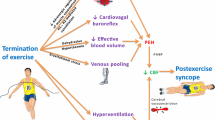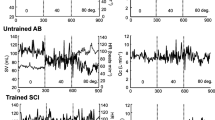Abstract
Athletes sometimes collapse either during or after exercise. Conditions that cause collapse during exercise may be life-threatening and account for 10–15% of all exercise-related medical encounters at endurance sporting events. These conditions are not always ’sports-specific’ and are managed according to the usual clinical care guidelines. The majority (>85%) of exercise-related collapse occurs after athletes have completed the event and key features are that patients are fully conscious and they have no clinical evidence for other serious medical conditions, but they have postural hypotension (blood pressure usually <100mm Hg) with unexpectedly low heart rates (<100 beats per minute). The cause of the postural hypotension appears to be the combination of physiological changes induced by exercise that tend to maintain a state of abnormally low peripheral vascular resistance for some hours after exercise. The most appropriate treatment for these patients is the supine position with the legs and pelvis above the level of the heart. Additional therapeutic interventions should be reserved for those who fail to respond adequately (blood pressure >100mm Hg; normal heart rate) to this simple treatment.
Similar content being viewed by others
References
Holtzhausen LM, Noakes TD. Collapsed ulbaenduranceathlete: proposed mechanisms and an approach to management. Clin J Sport Med 1997; 7 (4): 292–301
Bryant J. The London Marathon: the history ofthegreatest race on earth. London: Hutchinson, 2005
Adolph EF. Signs and symptoms of desert dehydration. In: Adolph EF, Brown AH, Goddard DR, et al., editors. Physiology of man in the desert. New York: Interscience Publishers Inc., 1947: 226–40
Lee DHK. Terrestrial animals in dry heat: man in the desert. In: Dill DB, editor. Handbook of physiology: adaptation to the environment. Washington, DC: American Physiology Society, 1964: 551–82
Pugh LG, Corbett JL, Johnson RH. Rectal temperatures, weight losses, and sweat rates in marathon running. J Appl Physiol 1967; 23 (3): 347–52
Wyndham CH, Strydom NB. The danger of an inadequate water intake during marathon running. S Afr Med J 1969; 43 (29): 893–6
Cade R, Spooner G, Schlein E, et al. Effect of fluid, electrolyte, and glucose replacement during exercise on performance, body temperature, rate of sweat loss, and compositional changes of extracellular fluid. J Sports Med Phys Fitness 1972; 12 (3): 150–6
O’Donnell Jr TF. The hemodynamic and metabolic alterations associated with acute heat stress injury in marathon runners. Ann N Y Acad Sci 1977; 301: 262–9
Barcroft H, Edholm OG, McMichael J, et al. Posthaemorrhagic fainting: study by cardiac output and forearm blood flow. Lancet 1944; 1: 489–90
Noakes TD. The forgotten Barcroft/Edholm reflex: potential role in exercise associated collapse. Br J Sports Med 2003; 37 (3): 277–8
Rowell LB. Human circulation: regulation during physical stress. New York: Oxford University Press, 1986
Halliwill JR. Mechanisms and clinical implications of postexercise hypotension in humans. Exerc Sport Sci Rev 2001; 29 (2): 65–70
Chandler MP, Rodenbaugh DW, DiCarlo SE. Arterial baroreflex resetting mediates postexercise reductions in arterial pressure and heart rate. Am J Physiol 1998; 275 (5 Pt 2): H1627–34
Halliwill JR, Taylor JA, Eckberg DL. Impaired sympathefic vascular regulation in humans after acute dynamic exercise. J Physiol 1996; 495 (Pt 1): 279–88
Lockwood JM, Wilkins BW, Halliwill JR. H1 receptor-mediated vasodilatation contributes to postexercise hypotension. J Physiol 2005; 563 (Pt 2): 63342
McCord JL, Beasley JM, Halliwill JR. H2-receptor-mediated vasodilation contributes to postexercise hypotension. J Appl Physiol 2006; 100 (1): 67–75
Williamson JW, McColl R, Mathews D. Changes in regional cerebral blood flow distribution during postexercise hypotension in humans. J Appl Physiol 2004; 96 (2): 719–24
Carter R, Cheuvront SN, Vernieuw CR, et al. Hypohydration and prior heat stress exacerbates decreases in cerebral blood flow velocity during standing. J Appl Physiol 2006; 101 (6): 1744–50
Acknowledgements
The author’s research, on which this review is based, is funded by the Medical Research Council of South Africa, the Harry Crossley and Nellie Atkinson Staff Research Funds of the University of Cape Town, Discovery Health and the National Research Foundation of South Africa through its THRIP initiative. Timothy D. Noakes is a contracted researcher for Bromar Foods Pty Ltd.
Author information
Authors and Affiliations
Corresponding author
Rights and permissions
About this article
Cite this article
Noakes, T.D. Reduced Peripheral Resistance and Other Factors in Marathon Collapse. Sports Med 37, 382–385 (2007). https://doi.org/10.2165/00007256-200737040-00028
Published:
Issue Date:
DOI: https://doi.org/10.2165/00007256-200737040-00028




